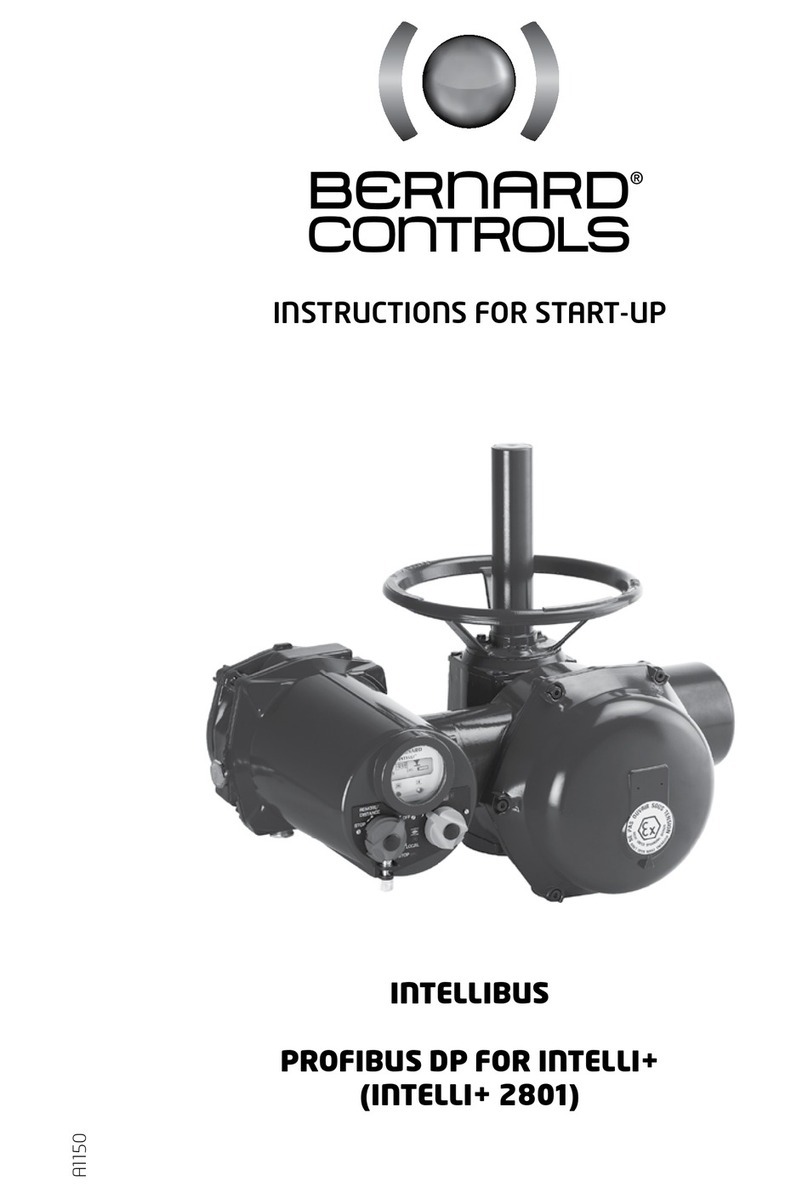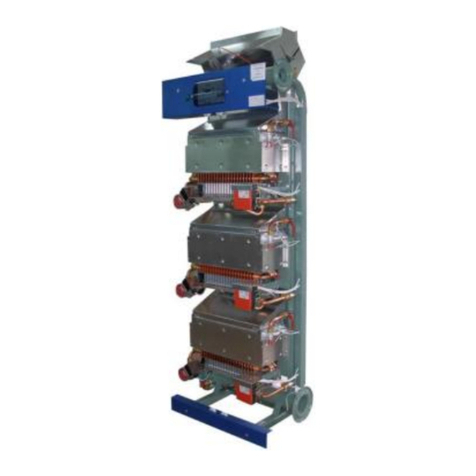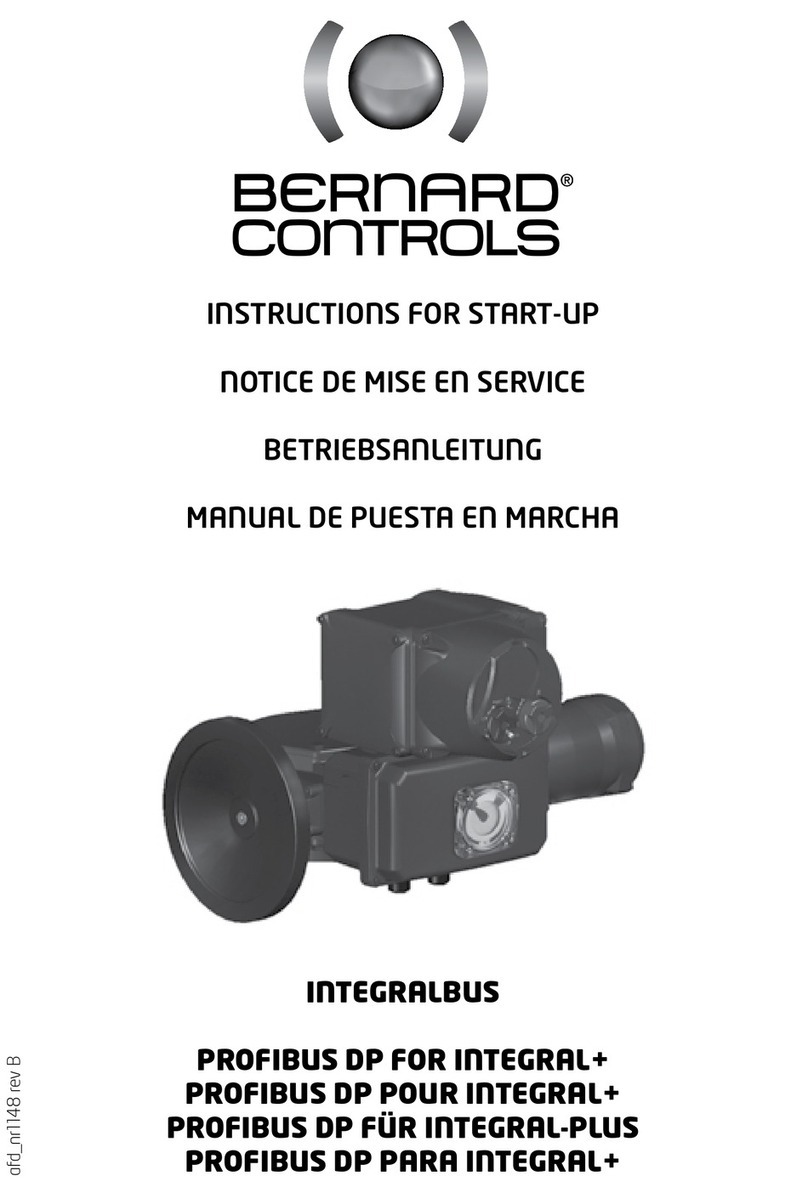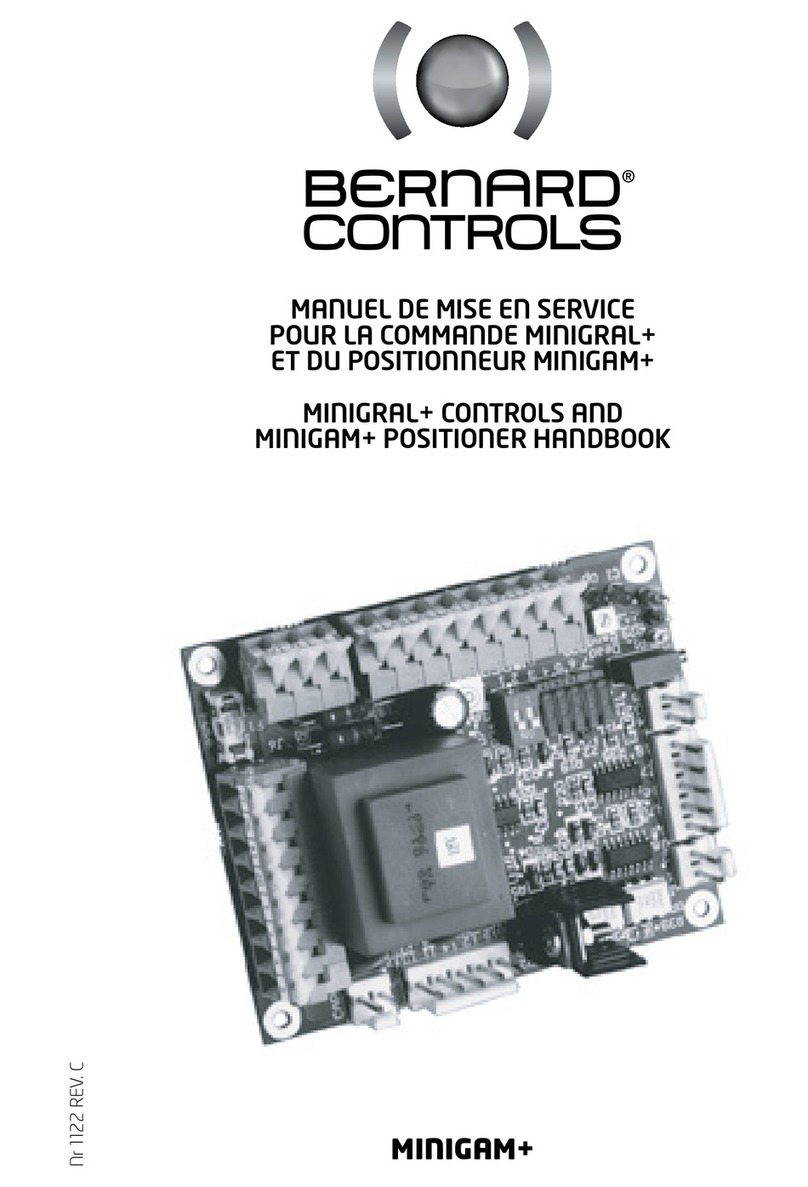Bernard LEB Instructions for use

Istruzioni di messa in servizio, stoccaggio
e manutenzione
-
Instructions for start-up, storage
and maintenance
Modello / Model : LEB
NR1141 I / A rev. A
LE
Gamma
Range

SCHEMO DI CABLAGGIO LEB VERSIONE ON/OFF
CABLAGGIO SERVOMOTORE CABLAGGIO CLIENTE
/ Opzioni
Protezione termica motore
APERTO
Contatti fine corsa
CHIUSO
Contatti fine corsa disponibili
posizione
Aperto
Intermedio
Chiuso
Aperto
Chiuso
Resistenza anticondensa
Potenziometro
Alimentazione /
Trasmettitore di posizione
fili
fili
Trasmettitore di posizione
Neutro
Alimentazione
Fase
Apertura
Chiusura
SCHEMO DI CABLAGGIO LEB VERSIONE COMANDO PROPORZIONALE
CABLAGGIO SERVOMOTORE CABLAGGIO CLIENTE
Protezione termica motore
Comando Proporzionale
Alimentazione elettrica
Contatti fine corsa liberi Aperto
Chiuso
Segnale di ricopia posizione
Segnale in entrata (comando)
Comando Ricopia

1. SAFETY INFORMATION
This device complies to current applicable safety
standards.
Installation, maintenance and use of this apparatus will
have to be done by skilled and trained staff only.
Please read carefully the whole document prior to
mounting and starting-up.
2. ASSEMBLY
Actuator should be secured directly to the valve using
proper bolts or via a proper interface.
After assembly, the actuator can operate in any position.
However, cable glands should not be oriented upwards
(loss of water tightness) and the motor will preferably not
be positioned at the bottom (potential internal
condensation trap)
Note 1 : do not handle the actuator by handwheel, it could
damage the gearworm.
Note 2 : see §.8 for details on storage precaution prior to
starting-up.
3. ELECTRICAL CONNECTIONS AND TESTS
Please refer to the diagrams included in this document and
respect the terminals numbering to perform the electrical
wiring.
A motor thermal protection is built-in and has been pre-
wired at the factory.
Once the actuator wiring is completed, the following points
must be checked :
a) Make sure that power supply voltage and frequency
are in accordance with the data engraved on the
actuator nameplate,
b) Check that all cable glands are correctly tightened,
c) Move the valve with the handwheel to an intermediate
position,
d) Operate electrical opening and closing travels and
check that the motor rotates in the right direction and
stops .
If any misfunction was detected at this stage, please check
the overall wiring.
4. SETTING OF MECHANICAL STOPS AND
TRAVEL LIMIT SWITCHES
Mechanical stops description and function
(1/4 Turn only) :
These items avoid any over-travelling during
handwheel operations.
Fine adjustment of the stop screws position is
possible within a limit of ± 2° maximum.
Travel limitation cams and switches system
description :
The cams operating the limit switches are
mounted on the position indicator stem.
Each cam can be set independently of the others.
1. SICUREZZA
Questo apparecchio è conforme alle norme di sicurezza in
vigore. Tuttavia, solo un’installazione, una manutenzione
ed un’utilizzazione effettuata da personale qualificato e
preparato permettono di assicurare un livello di sicurezza
adeguato.
Prima del montaggio e dell’avviamento, leggere
attentamente questo manuale.
2. MONTAGGIO
Il servomotore dev’essere imbullonato sull’apparecchio da
motorizzare.
I servomotori BERNARD possono funzionare in tutte le
posizioni. Tuttavia, i pressa-cavi non devono essere
orientati verso l’alto (per la tenuta) e il motore,
possibilmente, non dev’essere posto in posizione bassa
(per eventuale formazione di condensa all’interno).
Nota 1 : non trasportare il servomotore per il volantino, per
non danneggiare vite e ingranaggio.
Nota 2 : vedere §.8 per le precauzioni di stoccaggio prima
dell’avviamento.
3. CONNESSIONI ELETTRICHE E PROVE
Fare riferimento allo schema di cablaggio incluso in questa
documentazione e rispettare la numerazione dei morsetti.
Una protezione termica del motore è stata precablata in
fabbrica.
Una volta che il cablaggio è terminato, effettuare i seguenti
controllii:
a) Basandosi sulle informazioni incise sulla placca di
identificazione del servomotore, verificare che la
tensione di alimentazione utilzzata sia corretta.
b) Verificare che i pressa-cavi siano ben serrati dopo il
cablaggio.
c) Servendosi del comando manuale, portare la valvola in
posizione mediana.
d) Azionare il comando elettrico di apertura e poi di
chiusura. Verificare che il senso di rotazione del
servomotore sia corretto e che si fermi esattamente
nella posizione desiderata.
Se qualche malfunzionamento viene rilevato in questa
fase, controllare il cablaggio.
4. REGOLAZIONE DEI FERMI MECCANICI
E DEI CONTATTI DI FINE CORSA
Descrizione e funzione dei fermi meccanici
(solo per 1/4 di giro):
Questo dispositivo limita meccanicamente la
corsa durante la manovra manuale della
valvola e ciò evita qualsiasi danno.
Un’ulteriore regolazione è possibile grazie
alle viti di arresto entro un limite di 2° ad ogni
estremità.
Descrizione del sistema di cammes e contatti
di fine corsa:
Le 4 cammes che azionano i microinterruttori
possono essere regolate indipendentemente le
une dalle altre.
Nota: il servomotore viene pre-regolato in fabbrica per
una corsa di 90°. Se viene fornito montato su una
valvola, la regolazione delle posizioni aperto/chiuso
dev’essere fatta dal fornitore della valvola
Nota : the actuators are set at the factory for a 90°
travel. Moreover, if the actuator has been supplied
mounted on a valve, open/close positions tuning
should has been performed by the valve supplier .

Procedure of mechanical stops and travel limit switches
setting :
a) Loosen stop screws by 2 turns (1/4 Turn only).
b) Manually drive the valve to the closed position. For the
1/4 Turn devices, if mechanical stops are reached
before the valve closing is completed, it means that the
2° maximum adjustment tolerance has been exceeded
; do not try to go beyond this limit.
c) Set the black cams.
d) Turn the stop screw located by the actuator name plate
clockwise to the mechanical contact, reloosen 1.5 turn,
and secure by lock nut.
Proceed in the same way dor the open position (white
cams and stop screw located by the the motor).
Perform complete electrical valve opening and closing
operations. It is mandatory that the motor stops on the
travel limit switch and not on the mechanical stop (check
available extra travel to the stop with handwheel).
5. POSITION FEEDBACK POTENTIOMETER (OPTION)
The potentiometer used for actuator signal feedback is
driven by the visual position indicator.
0% position corresponds to a closed valve. 100% to an
open valve.
Circuit board mounted version
Resistance value is measured between
terminals 16 and 17.
Drive the actuator to the closed position.
Unscrew the vis located just under the large
pinion (A) and turn the smal pinion (B) so that
the resistance value exceeds 0 Ohm and
regularly increases then turn backwards to
reach a value as close to 0 Ohm as possible.
Tighten the large pinion screw.
Drive the actuator to the open position and
write down the resistance value corresponding
to the 100% position.
Come back to the closed position and check that, for the
0% position, the resistance shows a close to zero
repeatable value.
Signal inversion :
To inverse the signal variation direction, invert
potentiometer wires on the actuator terminal board (e.g.for
a connection on 16/17/18, invert 16 and 18).
Procedura di regolazione dei fermi meccanici e delle
cammes:
a) Allentare i due fermi meccanici di 2 giri.
b) Portare la valvola in posizione chiuso. Se si arriva
contro i fermi meccanici prima di aver ottenuto la
chiusura completa della valvola, significa che la
tolleranza massima di regolazione di 2° è stata
oltrepassata; non tentare di oltrepassare questo limite.
c) Regolare la posizione delle cammes nere.
d) Girare il fermo situato presso la placca di
identificazione dell’apparecchio fino al contatto ed
allentarla di 1,5 giri, poi bloccare la vite del fermo con
il controdado.
Rispettare la stessa procedura per l’apertura (cammes
bianche e fermo meccanico dalla parte del motore)
Effettuare una chiusura e un’apertura completa con il
comando elettrico.E’tassativo che l’arresto del motore sul
fine corsa elettrico avvenga prima dell’arrivo sul finecorsa
meccanico.
5. POTENZIOMETRO DI RICOPIA DELLA POSIZIONE
(OPZIONE)
Il sistema di ricopia della posizione è costituito da un
potenziometro collegato all’indicatore di posizione. Lo 0%
corrisponde a valvola chiusa, il 100% a valvola aperta.
Regolazione :
La misura della resistenza si effettua tra i
morsetti 16 e 17.
Portare il servomotore in posizione chiuso.
Allentare la vite situata sotto il pignone
grande (A) e ruotare il pignone piccolo (B)
fino ad ottenere un valore di resistenza che
superi 0 Ohm ed aumenti regolarmente, poi
girare in senso inverso fino ad arrivare ad un
valore prossimo a 0 Ohm.
Ristringere la vite del pignone grande.
Mettere il servomotore in posizione aperto e
annotare il valore di resistenza per il 100%.
Ritornare in posizione chiuso e verificare che il valore dello
0% sia ben ripetuto e vicino a 0 Ohm.
Inversione del segnale
Per cambiare il senso di variazione del segnale, invertire il
collegamento sui morsetti (esempio: per una connessione
16/17/18, invertire 16 e 18).
Funzione della camme
(identificazione del contatto) Colore
Segnalazione posizione
chiuso (ETLSC)
Segnalazione posizione
aperto (ETLSO)
Arresto del motore in
posizione chiuso (TLSC)
Arresto del motore in
posizione aperto (TLSO)
Colour Cam function
(associated contact mark)
Closed position signaling
(ETLSC)
Open position signaling
(ETLSO)
Stops motor in closed position
(TLSC)
Stops motor in open position
(TLSO)

6. "TAM" POSITION TRANSMITTER (OPTION)
The TAM transmitter delivers a 0/4 to 20 mA signal linearly
proportional to the angular position of the valve.
Electric connections
Refer to the wiring diagram supplied within this document.
Filtered or stabilised power supply shall be provided within
the 12 to 32 VDC range.
Maximum admissible ohmic load values are given in the
following table :
Settings
Connect a milliampermeter at the place of burden.
- Always start by adjusting the 0/4mA.
- Drive actuator to the closed position,
- Unscrew the screw located under the large pinion (A) and
turn the small pinion (B) so that the output
current reaches a minimum value. Turn
backwards until the current value regularly
increases then turn backwards again and stop
as soon as the minimum value determined
here above has been reached.
The potentiometer is then positioned at the
very beginning of its track.
- Tighten the large pinion screw.
- Precisely adjust the 0/4 mA with the TAM (C)
adjustment screw marked as "0/4mA".
- Drive the actuator to the position
corresponding to the 20 mA (open in standard),
-Turn the screw marked "20mA" in order to read exactly 20
mA on the milliampermeter.
- Come back to the closed position and check that, for the
0% position, the signal current shows a close to 0/4 mA
and repeatable value.
7. PROPORTIONAL CONTROL BOARD (OPTION)
The proportional control board allows to drive the valve to
intermediate positions.
Perform the electrical wiring
according to the “Positioner version”
diagram supplied in this document.
2 Led turn on to indicate a that the
actuator is running (green for the
opening direction / red for the
closing direction).
Configuration
The type of control and position
feedback signals can be selected by
the mean of 3 micro switches :
6.TRASMETTITORE DI POSIZIONE “TAM” (OPZIONE)
Il TAM trasmette a distanza una posizione angolare. Il
segnale di uscita è una corrente variabile da 0/4 a 20mA ,
secondo un rapporto lineare in funzione dell’angolo di
rotazione dell’asse d’entrata di un potenziometro.
Connessioni elettriche
Effettuare la connessione elettrica secondo lo schema
incluso in questo documento.
L'alimentazione deve essere compresa tra 12 e 32V in
corrente continua, raddrizzata, filtrata o stabilizzata e con
un carico massimo ammissibile precisato nella tabella:
Regolazione
Collegare un milliamperometro, con o senza carico, per
leggere la corrente di uscita.
- La regolazione deve sempre cominciare da 0/4mA.
- Portare il servomotore in posizione chiuso.
- Allentare la vite situata sotto il pignone
grande (A) e ruotare il pignone piccolo (B)
fino a raggiungere il punto dove la corrente
tocca il suo valore minimo. Cercare la zona
dove il segnale aumenta regolarmente, poi
girare in senso inverso fino a tornare al valore
minimo precedentemente trovato. Il
potenziometro è così posizionato ad inizio del
suo percorso.
- Ristringere la vite del pignone grande.
-
Regolare con precisione lo 0/4 mA per
mezzo della vite del TAM (C) segnata
"0/4mA".
- Portare ora il servomotore in posizione aperto.
- Girare la vite di regolazione segnata "20mA" per
leggere esattamente sul milliamperometro 20mA.
- Ritornare in posizione chiuso e verificare che il valore
dello 0% sia ben ripetuto e vicino a 0/4 mA.
7. COMANDO PROPORZIONALE (OPZIONE)
La scheda di comando proporzionale permette di
posizionare la valvola nelle posizioni intermedie.
Effettuare il collegamento elettrico
secondo lo schema “versione
posizionatore”
Dei led si illumineranno per indicare
che una manovra è in corso (verde
per l’apertura / rosso per la
chiusura).
Configurazione
I tipi di segnale di comando e di
ricopia sono configurabili a mezzo di
tre microinterruttori :
12
24
30
150
750
1050
Alimentazione
Volt Massimo carico
ammissibile Ohm
0-10V
4-20mA
0-20mA
3
B
A
A
Segnale
d'ingresso 1
B
A
B
Posizione degli
interruttori
2
B
A
A
0-20mA
4-20mA
0-20mA
Segnale
d’uscita
12
24
30
150
750
1050
Power supply
Volt Maximum
load Ohm
0-10V
4-20mA
0-20mA
3
B
A
A
Input
signal 1
B
A
B
Switches
configuration
2
B
A
A
0-20mA
4-20mA
0-20mA
Output
signal

Settings
Connect a milliamperemetre with or without loadbetween
terminal 71 and 72 in order to read the output signal.
- Setting always starts with the 0/4mA.
- Drive the actuator to the closed position
- Unscrew the screw located under the large
pinion (A) and turn the small pinion (B) so that
the output current reaches a minimum value.
Turn backwards until the current value regularly
increases then turn backwards again and stop
as soon as the minimum value determined here
above has been reached.
The potentiometer is then positioned at the very
beginning of its track.
- Tighten the large pinion screw.
- Drive the actuator to the open position,
- Precisely adjust the 20mA with the proportional
control board potentiometer marked as “P1”.
- Come back to the closed position and check that, for the
0% position, the signal current shows a close to 0/4 mA
and repeatable value.
The dead band adjustment should be adjusted only if the
actuator is “hunting” (e.g it cannot stop at the desired
position and keeps on moving around it).
In this case, use a small screwdriver to adjust the "Dead
Band" potentiometer value until the actuator stops and
stays at the desired position.
8. HEATER RESISTANCE (OPTION)
The heater resistance board prevents built-up of water
condensation inside the actuator in case of use in a very
humid atmosphere and large ambiant temperature
variations.
The diagram below indicates the advised actuator power
supply wiring for models equiped with the heating device.
(Neutral wired through the heater resistance board).
Regolazione
Collegare un milliamperometro, con o senza carico, per
leggere la corrente di uscita tra i morsetti 71 e 72.
- La regolazione deve sempre cominciare da 0/4mA.
- Portare il servomotore in posizione chiuso.
- Allentare la vite situata sotto il pignone grande
(A) e ruotare il pignone piccolo (B) fino a
raggiungere il punto dove la corrente tocca il
suo valore minimo. Cercare la zona dove il
segnale aumenta regolarmente, poi girare in
senso inverso fino a tornare al valore minimo
precedentemente trovato. Il potenziometro è
così posizionato ad inizio del suo percorso.
- Ristringere la vite del pignone grande.
- Portare ora il servomotore in posizione aperto
- Regolare il potenziometro P1 della scheda di
comando proporzionale per leggere
esattamente sul milliamperometro 20mA.
- Ritornare in posizione chiuso e verificare che il valore
dello 0% sia ben ripetuto e vicino a 0/4 mA.
La regolazione della banda morta (Dead Band), è
necessaria solo se il servomotore “pompa” ( impossibilità
di arrestarsi su una posizione fissa). In questo caso, con
un piccolo cacciavite, modificare il valore del
potenziometro " Dead Band " fino a che il servomotore si
arresta nella posizione desiderata senza ripartire.
8. RESISTENZA ANTICONDENSA (OPZIONE)
La scheda resistenza anticondensa permette di evitare la
condensa all’interno del servomotore nel caso di
utilizzazione in ambiente umido con dei forti sbalzi di
temperatura.
Lo schema qui sotto mostra il cablaggio dell’alimentazione
del servomotore consigliata per i modelli dotati di
resistenza anticondensa (cablaggio del neutro attraverso
la scheda anticondensa).
Attenzione: oltre che dalla scheda di posizionamento
l’arresto del motore può essere causato
dall’attivazione di uno dei seguenti contatti :
- contatto di fine corsa aperto o chiuso (cfr §4),
- protezione termica del motore.
Se il servomotore si arresta in una posizione che non
è quella desiderata, verificare che l’alimentazione del
motore non sia stata interrotta
da uno di questi contatti.
Note : the motor can be stopped by the positioner
board but also by the activation of one of the
following contacts :
- open or closed end of travel contact (cf §4),
- motor thermal protection switch.
If the actuator stops at a position which is not the
one required, please check the status of these three
contacts.

9. ISTRUZIONI PER LA MANUTENZIONE E LO
STOCCAGGIO DEI SERVOMOTORI
Manutenzione
Se il servomotore è utilizzato in atmosfera particolarmente
umida, è consigliabile verificare almeno una volta all’anno
che non si sia formata della condensa all’interno
dell’alloggiamento delle parti elettriche. Per evitare questa
condensa, i servomotori possono essere equipaggiati, in
opzione, con una resistenza anticondensa.
I nostri servomotori sono lubrificati con grasso a vita. In
caso di necessità di rimuovere il grasso originale, vogliate
contattarci.
Stoccaggio
a) I servomotori devono essere immagazzinati al coperto,
in un luogo pulito e secco e protetti dagli sbalzi di
temperatura. Evitare l’immagazzinaggio al sole diretto.
b) Per i servomotori equipaggiati con resistenza
anticondensa, alimentarla in caso di presenza di
umidità (la tensione è indicata sulla targhetta).
c) Verificare che i tappi in plastica provvisori dell’ingresso
cavi siano ben chiusi, assicurarsi della buona tenuta
dei coperchi e delle scatole contenenti gli elementi
elettrici.
Servomotori installati ma in attesa di collegamento
elettrico
Se è previsto un lungo periodo di tempo tra il montaggio
del servomotore e i lavori di connessione elettrica:
a) Assicurarsi della buona tenuta dei pressacavi e dei
contatti elettrici.
b) Ricoprire la motorizzazione con un film di plastica.
c) Per i servomotori equipaggiati con resistenza
anticondensa, alimentarla in caso di presenza di
umidità (la tensione è indicata sulla targhetta).
Controlli dopo lo stoccaggio
a) Controllare visivamente l’equipaggiamento elettrico.
b) Effettuare qualche manovra manualmente.
c) Procedere alla messa in servizio del servomotore
secondo le istruzioni sopra riportate.
9. MAINTENANCE AND STORAGE INSTRUCTIONS
Maintenance
If the actuator is correctly mounted and sealed, no special
maintenance is required. Check once a year function of
motor and make sure that switch compartment is
condensation free. If environment is humid, we
recommend the installation of an anti-condensation heater
resistance and/or breathers, thus protecting electric parts
from alteration.
Actuators are lubricated with grease for lifetime. If the
grease requires to be renewed, please contact us.
Storage
a) The actuators should be stored under a shelter, in a
clean and dry place and protected from wide
temperature variations. Avoid placing the actuators
directly on the floor.
b) For actuators equipped with an heating resistance, it is
recommended to connect and supply it if the storage
area is humid (check voltage on actuator name plate).
c) Check that the temporary sealing plugs of the cable
entries are well in place.Make sure that the covers and
the boxes are well closed to ensure weatherproof
sealing.
Actuators installed on site but waiting for electrical
connection
If a long period of time is expected between the actuator
mounting and the electrical wiring works :
a) Visually check the tightness of electrical box cover and
cable glands.
b) Cover the device with a plastic protective film.
c) For actuators equipped with an heating resistance, it is
recommended to connect and supply it if the storage
area is humid (check voltage on actuator name plate).
Control after storage
a) Visually check the electric equipment,
b) Operate apparatus manually,
c) Proceed to the actuator setting-up according to the
instructions above.

4 rue d'Arsonval - BP91 - 95505 GONESSE CEDEX. France
Tel. +33.1.34.07.71.00 - Fax +33.1.34.07.71.01
AUSTRALIA FCX PEGLER BEACON
Tel : + 61 3 97 65 61 11
Fax : + 61 3 97 65 61 65
AUSTRIA IPU ING PAUL UNGER
Tel : +43 1 602 41 49
Fax : +43 1 603 29 43
BELGIUM BERNARD BENELUX SA
christian.baert@ bernard-benelux.com BRUXELLES
Tel : +32 2 34 34 122
Fax : +32 2 34 72 843
BRAZIL JCN
Tel : +55 11 39 02 26 00
Fax : +55 11 39 02 40 18
CHINA BERNARD BEIJING OFFICE
Tel : +86 10 8739 77 27
Fax : +86 10 8739 77 04
CZECH REPUBLIC FLUIDTECHNIK BOHEMIA s.r.o.
Tel : +420 548 213 233-5
Fax : +420 548 213 238
DENMARK ARMATEC A/S
www.armatec.dk Tel : +45 46 96 00 00
Fax : +45 46 96 00 01
FINLAND OY SOFFCO AB
www.soffco.fi Tel : +358 9 54 04 620
Fax : +358 9 54 04 6250
GERMANY DEUFRA GMBH
www.deufra.de Tel : +49 22 41 98 340
Fax : +49 22 41 98 34 44
GREECE PI&MS
Tel : +30 2 10 66 69 129
Fax : +30 2 10 66 69 130
HUNGARY APAGYI TRADEIMPEX KFT
Tel : +36 1 223 1958
Fax : +36 1 273 0680
INDIA INSTRUMENTATION LTD
Tel : +91 491 56 61 27
Fax : +91 491 56 61 35
www.chemtrolssamil.com MUMBAI
Tel : +91 22 2857 9992
Fax : +91 22 2857 9995
ITALY BERNARD SERVOMOTORI
Tel : +39 02 93 90 60 22
Fax : +39 02 93 90 42 46
JAPAN BERNARD JAPAN
yoshiro.shimizu@pechiney.com c/o Pechiney Japan
TOKYO
Tel : +81 3 33 49 66 39
Fax : +81 3 33 49 67 50
KOREA (Rep of) Water & environment :
www.humanitc.com SEOUL
Tel : +82 2 532 2604
Fax : +82 2 3478 7089
Power industry :
KYONGGI
Tel : +82 31 718 15 08
Fax : +82 31 718 34 08
MALAYSIA ACTUATION & CONTROLS ENGINEER
Tel : +60 7 23 50 277 / 23 50 281
Fax : +60 7 23 50 280 / 23 50 285
MIDDLE-EAST BERNARD MIDDLE-EAST
Tel : +971 4 39 80 726
Fax : +971 4 39 80 726
MOROCCO AQUATEL sarl
Tel : +212 22 66 55 71
Fax : +212 22 66 55 74
NETHERLANDS BERNARD BENELUX NV
Tel : +31 30 24 14 700
Fax : +31 30 24 13 949
NORWAY FAGERBERG NORGE a.s
www.fagerberg.no Tel : +47 69 35 55 30
Fax : +47 69 35 55 31
POLAND MARCO
Tel : +48 22 864 55 43
Fax : +48 22 864 94 22
PORTUGAL PINHOL, GOMES & GOMES LDA.
Tél : +351 21 425 68 50
Fax : +351 21 425 68 59
RUSSIA A.E.T.
Tel : +7 812 320 55 97
Fax : +7 812 320 55 97
SINGAPORE ACTUATION &CONTROLS ENG. (ASIA)
Tel : +65 65 654 227
Fax : +65 65 650 224
SPAIN BERNARD SERVOMOTORES
Tel : +34 91 30 41 139
Fax : +34 91 32 73 442
SWEDEN G. FAGERBERG AB
www.fagerberg.se Tel : +46 31 69 37 00
Fax : +46 31 69 38 00
SWITZERLAND MATOKEM AG
www.matokem.com Tel : +41 61 483 15 40
Fax : +41 61 483 15 42
THAILAND BERNARD SOUTH-EAST ASIA
BANGKOK
Tel : +66 2 640 82 64
Fax : +66 2 640 83 12
UNITED ARABS EMIRATES EMIRATES HOLDINGS
Tel : +97 12 644 73 73
Fax : +97 12 644 40 66
UNITED-KINGDOM ZOEDALE Plc
www.zoedale.co.uk Tel : +44 12 34 83 28 32
Fax : +44 12 34 83 28 00
USA BERNARD CONTROLS Inc
www.bernardcontrols.com Tel : +1 281 578 66 66
Fax : +1 281 578 27 97
Other Bernard Industrial Equipment manuals





















